Yoga Teacher Training Classes at Aura Wellness Center in Attleboro, MA
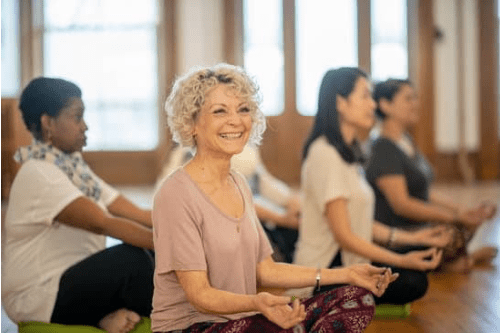
Experienced yoga teachers and interns need convenient options for training. If you are teacher running a Yoga studio, you may not be able to shut it down for a few weeks. As many of you know, we have online teacher training, but we also have sessions and workshops for foundational or continuing education. Our online programs have become popular because they are approved by Yoga Alliance. Additionally, continuing education courses at Aura Wellness Center are approved for Yoga Alliance Continuing Education Provider (YACEP) credits.
* If you would like to speak to an Aura Staff Member in person, please schedule an appointment with us by calling 508-222-0092 or emailing us at info@aurawellnesscenter.com
Yoga Instructor Class Schedule:
- Monday: Private Sessions (Available by Appointment)
- Tuesday: Private Sessions (Available by Appointment)
- Wednesday: Private Sessions (Available by Appointment)
- Thursday: Private Sessions (Available by Appointment)
- Friday: Yoga Teacher Training (Available by Appointment)
Yoga Class Policies:
Policies for our Yoga classes can be found here.
Private Sessions for teachers are available by appointment in the following:
- Yoga Instructor Training
- Stress Management
- Yoga Nidra
- Mindfulness Meditation
- Chair Yoga
- Restorative Yoga
- Yoga Student Safety
- Principles of Vinyasa Flow
- Yogic Personal Fitness Training
- Yoga Teacher CECs for Yoga Alliance
- Learn more about our Yoga Student Services
*There is a $20 non-refundable deposit to reserve a private session.
This deposit will be deducted from your private session fee.
Click Here for Directions to Aura Wellness Center
Faculty (All Yoga Teachers Are Registered and Certified)
- Dr. Paul Jerard, E-RYT 500, YACEP
- Marie Jerard, E-RYT 500, YACEP
- Jacquline D. Stokes-Alves (Jackie), E-RYT 500, YACEP
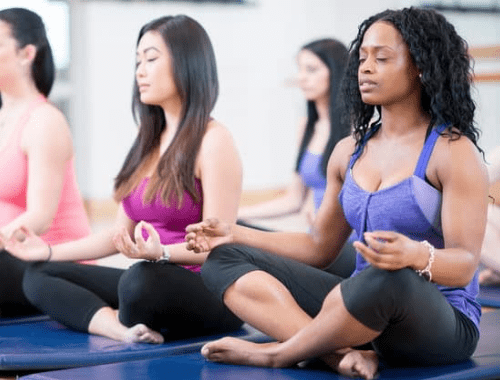
General Student Safety Guidelines for Yoga Classes
Wear comfortable clothing that allows you to move freely. It is best to practice barefoot.
Yoga should be practiced on an empty stomach: avoid eating 2-3 hours before class.
It is best to practice in a well-ventilated room that is neither too hot nor too cold.
When practicing Hatha Yoga poses (asanas), warm up with a few movements and deep breathing.
Yoga postures should be performed slowly and deeply if time is limited.
Don’t strain or struggle to get into your Yoga poses. Move gently, smoothly, and with awareness into and out of your postures. Don’t push through tightness; it’s much more effective–and much safer–to relax it away with awareness and with the breath, facilitating a deeper opening.
Use common sense: Follow the contraindications for poses and breathing exercises, even if you feel okay. (Contraindication refers to a condition, usually physical, which indicates one shouldn’t do a particular asana or pranayama. It comes from “contra,” which means against, and “indication.”
It is not wise to compete with others or with yourself in yoga. Pride of body or superior flexibility has no place in yoga. Progress in yoga is not absolute, but directional – it is a matter of taking your next steps forward.
Unless the pose or style requires a different, specific type of breathing, breathe diaphragmatically while holding an asana.
Movement Guidelines for Yoga Classes
Tuck the tailbone when necessary to lengthen the lower spine to avoid swayback (overarching the lower back). In some cases, contracting the lower abdomen seems more natural and can accomplish the same goal.
Keep your neck in line with the rest of your spine to avoid compressing the cervical vertebrae or disc.
Knees are hinge joints that fold with little to no rotation, so avoid twisting them.
Tension in the shoulders should be avoided; keep the neck extended and the shoulder blades relaxed.
If you tend to hyperextend your knees, keep your knees slightly bent or pull them up by engaging your quadriceps muscles.
If one leg supports most of your weight, keep your knee over the ankle (lower leg vertical) or slightly behind the ankle (i.e., don’t come down too far into the pose).
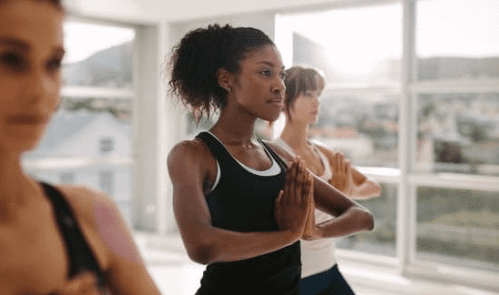
Spinal Movement
When bending forward, keep the spine long and fold at the hips. You can allow your spine to round slightly, but only through complete awareness, a long spine, and no discomfort. For maximum safety, keep the knees slightly bent throughout the pose. Avoid entering or exiting the pose with a rounded spine and straight knees, as this may compress intervertebral discs and pinch the spinal nerves.
By tucking the pelvis (lengthening the tailbone downward), releasing the shoulder blades away from the ears, and lifting through the sternum/heart area, you will protect the lower back (lumbar spine). If your neck needs support, make the curvature match (or be less than) the rest of your spine.
When doing side bends, keep the underside of your rib cage open so as not to restrict your breathing or overstretch your lateral flexor muscles.
Inverted and Seated Postures
If you are inverted, don’t put too much weight or stress on your neck, and don’t remove the natural curvature of your cervical spine. Until you can do the classical versions of the inverted poses, practice more straightforward variations if your arms and shoulders are not strong enough to bear the body’s weight.
In sitting poses, make sure that all rotation occurs in the hip joint, not the knee. The lotus pose is not recommended for beginners unless their hips are already quite flexible.

Yoga Teacher Training Today
Yoga has transcended its ancient roots to become a global wellness, mindfulness, and community movement. As more people embrace this transformative practice, the demand for skilled yoga instructors rises. If you’ve ever felt the pull toward sharing your love for yoga or seeking a deeper understanding of its philosophies and techniques, embarking on a yoga teacher training journey could be your next big step.
Whether you want to deepen your practice or inspire others on their yogic path, finding the right teacher training program is crucial. But what does it entail? What are the benefits? How do you navigate through the various options that are available today?
Join us as we explore everything you need about yoga teacher training—from different program types and preparation tips to specialization insights and career opportunities in this fulfilling field. Get ready to unlock new dimensions of knowledge that will elevate your teaching skills and enrich your life’s purpose.
The Benefits of Completing a Yoga Teacher Training Program
Completing a yoga teacher training program offers much more than the ability to teach. One of the most significant benefits is personal growth. Participants often develop greater self-awareness and confidence.
Additionally, this experience deepens your understanding of yoga philosophy and practice. You use various styles, techniques, and postures that enrich your practice.
Networking opportunities abound as well. Connecting with fellow trainees can lead to lasting friendships and professional collaborations later on.
Many graduates report a sense of community that extends beyond the training itself. It’s not just about learning; it’s about building relationships with like-minded individuals who share similar passions.
Earning a certification opens new doors in your career path—whether you choose to teach or integrate yoga into other professions like wellness coaching or physical therapy. The possibilities are endless when you complete this transformative journey.

Different Types of Yoga Teacher Training Programs Available
Yoga teacher training programs come in various styles and formats, catering to different interests and needs. Traditional 200-hour programs are the most common, providing a foundational understanding of yoga philosophy, asanas, and teaching methodologies.
Moreover, niche training exists, such as prenatal yoga or trauma-informed yoga. These programs equip instructors with unique skills to serve specific populations effectively.
Online options have also surged in popularity due to their flexibility. Virtual courses allow you to learn at your own pace while still accessing high-quality instruction.
Intensive retreats combine immersive learning experiences with travel opportunities. This format not only deepens practice but also fosters community among aspiring teachers. Each type offers distinct benefits tailored to diverse goals within yoga instruction.
What to Look for in a Quality Training Program
When searching for a quality yoga teacher training program, consider the accreditation. Look for programs recognized by reputable organizations like Yoga Alliance. This ensures you meet global teaching standards.
Next, evaluate the curriculum. It should cover anatomy, philosophy, and various styles of yoga. A well-rounded education prepares you to teach diverse yoga classes confidently.
Instructor experience also matters. Choose programs led by seasoned teachers with extensive backgrounds in both practice and instruction. Their insights can significantly enhance your learning journey.
Class size is another critical factor. Smaller groups allow for personalized feedback and support during your training.
Delve into reviews from past students. Their experiences will give you a clearer picture of what to expect from the program and its effectiveness in shaping competent instructors.
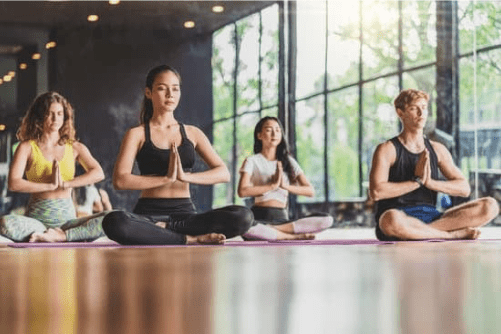
How to Prepare for Yoga Teacher Training
Preparing for yoga teacher training involves more than just physical readiness. Start by establishing a consistent practice. This helps you deepen your understanding and connection to teaching yoga classes.
Next, delve into anatomy and philosophy. Familiarize yourself with key concepts that will be covered in the program. Reading foundational texts can offer valuable insights.
Consider your goals for this journey. Reflect on why you want to teach and what impact you hope to have on others. This clarity will guide your experience.
Mentally prepare by embracing an open mindset. Expect challenges and growth during this transformative time.
Also, take care of your body before the training. Nourish yourself with healthy foods, stay hydrated, and prioritize rest when needed.
If possible, connect with fellow trainees or instructors ahead of time. Building relationships early can enrich your experience as you embark on this path together.
Common Misconceptions About Becoming a Yoga Teacher
Many people assume that becoming a yoga teacher is an easy path, simply requiring some basic knowledge of poses. In reality, it demands dedication and extensive training.
Another common misconception is that you must be flexible or have years of experience. While flexibility can enhance your practice, it’s not a prerequisite for teaching. Everyone begins somewhere.
Some believe yoga teachers are only about physical instruction. However, the role encompasses philosophy, anatomy, and emotional support. A good teacher fosters growth in their students beyond just asanas.
Many think teaching yoga guarantees financial security or popularity. The truth is that building a successful career takes time and effort in marketing and networking within the community.
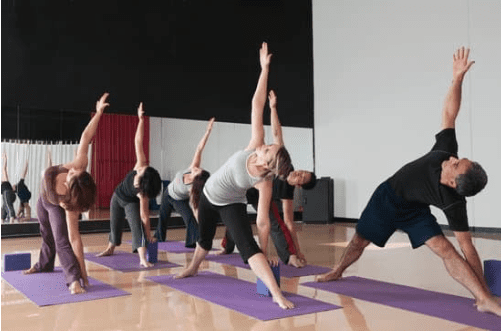
Understanding the Value of Specialization
Specialization in yoga teaching sets you apart from the crowd. As a newly certified instructor, diving deep into specific styles can enhance your expertise and appeal.
Consider focusing on areas like restorative or trauma-informed yoga. These specialties address unique needs within diverse communities, creating deeper connections with students.
Specialized knowledge also builds confidence. You’ll feel more equipped to guide classes and manage various challenges that may arise during sessions.
Moreover, specialized training often attracts dedicated practitioners seeking tailored experiences. It fosters loyalty and enhances your reputation as an expert in that niche.
Remember, specialization doesn’t confine you; it opens doors for collaboration with other instructors and wellness professionals. Embrace this opportunity to grow both personally and professionally in the vibrant world of yoga teacher training.
Continuing Education
Continuing education is essential for yoga teachers looking to stay current and deepen their practice. The world of yoga is ever-evolving, with new styles and techniques emerging regularly.
Participating in workshops or advanced training can enhance your skills. You’ll explore specialized areas like anatomy, mindfulness, and teaching methodologies. This not only enriches your knowledge but also boosts confidence when leading yoga classes.
Moreover, continuing education allows networking with other professionals in the field. Building relationships can open doors to potential collaborations or job opportunities.
Online courses have made learning at your own pace easier than ever. Whether you’re exploring trauma-informed practices or adapting poses for seniors, a wealth of resources is available.
Staying engaged in learning keeps the passion alive and enhances the experience for you and your students. Embrace every opportunity that comes your way; each step adds depth to your journey as an instructor.

Teaching Hatha Yoga Classes
Teaching Hatha yoga classes requires a solid understanding of the fundamentals. This style emphasizes alignment and breath control, making it ideal for beginners.
As an instructor, your role is to create a welcoming environment. Please encourage students to explore their limits while maintaining safety. Offer modifications for various skill levels to ensure everyone feels included.
Focus on clear verbal cues and demonstrations. Visual aids can enhance understanding, but remember that personal connections matter, too. Engage with each student, offering personalized feedback when necessary.
Incorporate mindfulness into your sessions by guiding participants through relaxation techniques at the end of class. This helps them absorb what they’ve learned while promoting mental clarity.
Hatha yoga is a foundation for many other styles; teach with passion and authenticity to inspire confidence in your students’ practice.
What Should Vinyasa Teachers Know?
Vinyasa teachers should possess a solid understanding of flow and transitions. The seamless movement from one pose to another is what sets Vinyasa apart. Mastering these connections not only enhances the class experience but also prevents injuries.
Knowledge of breath synchronization with movement is crucial. This technique helps students cultivate mindfulness, making each practice more rewarding. Please encourage your students to tune into their breath as they move through sequences.
Familiarity with various modifications for poses is essential, too. Every student comes in with different abilities and limitations. Being adaptable ensures everyone feels included and supported during their practice.
Understanding sequencing will allow you to create yoga classes that build energy progressively or gently wind down toward relaxation. Exploring themes within your sequences can deepen practitioners’ experience and keep them engaged.
Continuously evolving your knowledge about anatomy will enhance safety and effectiveness in every class you teach. Staying informed on the body’s mechanics enriches teaching methods and student experiences.

Is Teaching Chair Yoga for You?
Teaching chair yoga can be fulfilling for those passionate about making yoga accessible. This style is designed for individuals with limited mobility or those who prefer the support of a chair.
If you enjoy working with diverse populations, this might be your niche. You’ll connect with seniors, office workers, and others seeking gentle movement to enhance their well-being.
Consider your teaching style. If you emphasize compassion and inclusivity, chair yoga offers an excellent platform to inspire participants. Your classes will create a sense of community while building strength and flexibility.
Be prepared to adapt traditional poses. Creativity plays a big role here as you’ll find innovative ways to modify exercises without losing their essence.
Reflect on your motivations. Teaching chair yoga empowers students and enriches your practice through increased awareness and mindfulness in every session.
What About Pregnant Yoga Students?
Teaching yoga to pregnant students requires a unique approach. Expectant mothers experience numerous physical and emotional changes. It’s essential to create a safe, supportive environment.
First, understanding the physiological aspects of pregnancy is crucial. Modifications in poses help accommodate growing bellies and changing balance. Focus on gentle stretches that promote flexibility and strength without strain.
Encouraging mindfulness is equally essential during this stage. Breathing exercises can be invaluable for stress relief and preparing for labor. Foster an atmosphere where moms can connect with their bodies.
Always prioritize communication; encourage open discussions about any discomfort or concerns. Every pregnancy is unique, so adapting your classes accordingly will enhance the experience.
Consider incorporating partner support into sessions when appropriate. This not only strengthens relationships but also offers additional comfort during practice.

Teaching Restorative Yoga Classes
Teaching restorative yoga classes is a beautiful way to help students unwind and reconnect with their bodies. This style focuses on gentle poses held for extended periods, often supported by props. It allows practitioners to release tension deeply.
As an instructor, you create a safe space where students can let go of daily stresses. Use calming language and encourage mindful breathing throughout the session.
Introducing soothing music or dim lighting can significantly enhance the ambiance. Guide your participants into each pose gently, emphasizing relaxation rather than physical challenge.
Please encourage them to listen to their bodies and honor their limits. The goal is not perfection but rather comfort in stillness. You might also share tips on how they can integrate restorative practices into their daily lives for ongoing benefits beyond class time.
Is Teaching Hot Yoga for You?
Teaching hot yoga can be a thrilling yet demanding experience. The heated environment elevates the intensity of each pose, pushing both instructors and students to their limits.
This style might suit you well if you’re passionate about maintaining physical stamina and thrive under pressure. You should feel comfortable in high temperatures while keeping your focus sharp.
Consider your teaching style, too. Hot yoga often requires quick adjustments and clear communication amid the heat haze. It could be fulfilling if you enjoy guiding others through challenging sequences while fostering resilience.
However, remember that not everyone loves the heat. Some students may find it overwhelming or uncomfortable. Adaptability is vital when catering to diverse audiences in an intense setting.
Reflect on your own practice as well. Are you energized by the challenge? Your enthusiasm will significantly influence your students’ experiences.
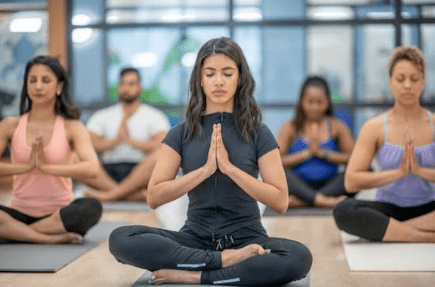
Teaching Trauma-Informed Yoga Classes
Teaching trauma-informed yoga classes requires a deep understanding of the complexities surrounding trauma. Creating a safe and supportive environment where students feel secure is essential.
These classes shift focus from traditional cues to more adaptive language. Emphasizing choice and autonomy empowers participants. Please encourage them to listen to their bodies without pressure or expectation.
Being attuned to non-verbal signals is crucial. Pay attention to how students react physically and emotionally during practice. Adjust your approach based on their needs, fostering an atmosphere of trust.
Incorporating mindfulness techniques can help ground practitioners in the present moment. Simple breathing exercises or gentle movements can facilitate healing and self-awareness.
Constantly remind students that stepping back is okay if they need space. By honoring individual experiences, you contribute positively to their journey toward recovery.
After Completing a Yoga Teacher Training Program
Completing your yoga teacher training is a significant milestone. You’ve immersed yourself in yoga’s practice, theory, and philosophy. Now comes the exciting part—putting that knowledge to use.
Many graduates find themselves eager to start teaching right away. Sharing what you’ve learned can be incredibly rewarding. Whether it’s leading classes at studios or hosting private sessions, opportunities abound.
It’s also essential to continue your journey as a teacher. Attend workshops and deepen your understanding of different styles or techniques. This commitment not only enhances your skills but also enriches the experience for your students.
Networking with fellow instructors can also open doors. Engaging with local yoga communities helps you stay connected, informed, and inspired.
Remember that each class you teach is an opportunity for growth—for both you and your students. Embrace this new chapter wholeheartedly; it’s just the beginning of an enriching adventure in yoga.

Creating Your Online Studio
Creating your online studio is an exciting venture for any yoga teacher. With digital platforms at our fingertips, the opportunities are endless.
First, select a streaming service that suits your needs. Platforms like Zoom or Vimeo offer user-friendly interfaces for live classes and recorded sessions.
Next, invest in quality equipment. A good camera and microphone enhance your students’ experience, making them feel connected even from afar.
We are designing an inviting space that matters to online students, too. Choose a calming backdrop with soft lighting to create a relaxing atmosphere during classes.
Don’t forget about marketing! Use social media to promote your classes and engage with potential students. Share snippets of your sessions or insightful tips related to yoga practice.
Consider offering different membership tiers. This can provide added value through exclusive content or personalized coaching plans tailored to individual goals.
Career Opportunities for Yoga Instructors
The landscape for yoga instructors is rich with opportunities. Many start by teaching classes at local studios or gyms, sharing their passion and expertise with diverse students.
Private sessions are another avenue to explore. Personalized training allows you to tailor lessons to individual needs, enhancing student experience while cultivating more profound relationships.
Corporate wellness programs have also gained popularity. Companies increasingly recognize the benefits of yoga on employee well-being and offer classes as part of their health initiatives.
Retreats and workshops present exciting options as well. These events let instructors share specialized knowledge in an immersive environment while expanding their reach beyond traditional settings.
Online platforms have revolutionized how instructors connect with students globally. Creating digital courses or live-streaming sessions can significantly broaden your audience, making it possible to teach from anywhere in the world.
Each path offers unique rewards and challenges, allowing every instructor to discover a niche that resonates with them.

Summary
Yoga teacher training offers a transformative journey for those passionate about sharing the practice. It equips aspiring teachers with essential skills, deepening both their personal and professional yoga experiences.
Diverse programs cater to various styles, from Hatha to Vinyasa. This variety ensures that every instructor can find their niche. Specialization is key in today’s yoga landscape.
Preparation plays a crucial role in maximizing your experience. Understanding common misconceptions helps clarify expectations and empowers new instructors.
The opportunities within this field are vast. Possibilities abound if you envision an online studio or seek teaching roles in studios or wellness centers.
Continuing education fosters growth as an instructor and keeps your yoga classes fresh and engaging. Embracing different areas like trauma-informed or chair yoga expands your reach to more students— opening doors to deeper connections through mindful movement.
Conclusion
Yoga teacher training is a transformative journey beyond learning poses and sequences. It’s about deepening your understanding of yoga, enhancing personal growth, and discovering ways to share this ancient practice with others. Whether you aspire to teach Hatha or Vinyasa or special populations like pregnant women or trauma survivors, diverse paths are available for every passion.
As you embark on this path, remember the importance of choosing a quality program that aligns with your goals. Preparing well will set the stage for success during and after your training. Embrace specialization to carve out your niche in the extensive world of yoga instruction.
The opportunities are plentiful—whether creating an online studio or teaching in-person classes. With ongoing education and commitment to growth, you can build a fulfilling career as a yoga instructor while enriching the lives of those around you with the gift of yoga. The journey awaits; it’s time to take that first step into your future as a yoga teacher.
